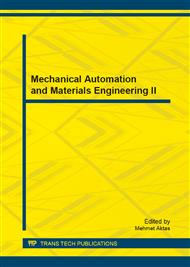p.611
p.616
p.621
p.625
p.630
p.636
p.641
p.646
p.650
Wear Analysis of Warm Extrusion Dies Using DEFORM
Abstract:
Based on a modified form of Archard’s wear theory, significant data were obtained using the finite element analysis code DEFORM during the process of warm extrusion, including instantaneous interface temperature, sliding velocity, and interface pressure distribution of every node. From the acquired data, the wear of the punch, the temperature–wear coefficient curve, temperature–wear depth curve, and temperature–hardness curve were acquired. The results show that the maximum wear occurred in the front working tape of the punch. The results are in agreement with actual conditions, and therefore, lay a foundation for forecasting die life and optimizing die cavity profiles using this method.
Info:
Periodical:
Pages:
630-635
Citation:
Online since:
June 2014
Authors:
Keywords:
Price:
Сopyright:
© 2014 Trans Tech Publications Ltd. All Rights Reserved
Share:
Citation:


